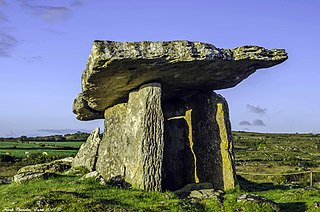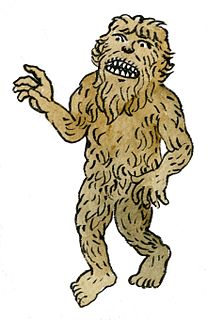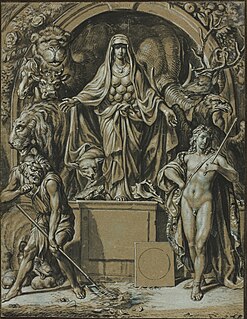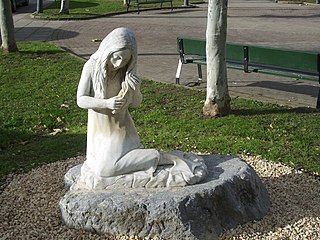Related Research Articles

A dolmen or portal tomb is a type of single-chamber megalithic tomb, usually consisting of two or more upright megaliths supporting a large flat horizontal capstone or "table". Most date from the early Neolithic and were sometimes covered with earth or smaller stones to form a tumulus. Small pad-stones may be wedged between the cap and supporting stones to achieve a level appearance. In many instances, the covering has eroded away, leaving only the stone "skeleton".

In folklore, giants are beings of human-like appearance, but are at times prodigious in size and strength or bear an otherwise notable appearance. The word giant is first attested in 1297 from Robert of Gloucester's chronicle. It is derived from the Gigantes of Greek mythology.

La chabola de la Hechicera is a dolmen group located in Elvillar, Álava, in the Basque Country in Spain. Three large vertical stones support a large horizontal flat stone. Nine large stones form a chamber in a polygonal shape. The corridor is made of five stones, and is divided into two. The site was probably a funerary construction to hold the remains of the people in the settlement.

In Breton folklore, a Korrigan is a fairy or dwarf-like spirit. The word korrigan means in Breton "small-dwarf". It is closely related to the Cornish word korrik which means gnome. The name changes according to the place. Among the other names, there are korrig, korred, korrs, kores, couril, crion, goric, kornandon, ozigan, nozigan, teuz, torrigan, viltañs, poulpikan, poulpiquet, and paotred ar sabad.

The mythology of the ancient Basques largely did not survive the arrival of Christianity in the Basque Country between the 4th and 12th century AD. Most of what is known about elements of this original belief system is based on the analysis of legends, the study of place names and scant historical references to pagan rituals practised by the Basques.
The mythologies in present-day France encompass the mythology of the Gauls, Franks, Normans, Bretons, and other peoples living in France, those ancient stories about divine or heroic beings that these particular cultures believed to be true and that often use supernatural events or characters to explain the nature of the universe and humanity. French myth has been primarily influenced by the myths and legends of the Gauls and the Bretons as they migrated to the French region from modern day England and Ireland. Other smaller influences on the development of French mythology came from the Franks.

The jentil, are a race of giants in the Basque mythology. This word meaning gentile, from Latin gentilis, was used to refer to pre-Christian civilizations and in particular to the builders of megalithic monuments, to which the other Basque mythical legend the Mairuak are involved too.

Mother Nature is a personification of nature that focuses on the life-giving and nurturing aspects of nature by embodying it, in the form of the mother.
Encantado may refer to:

Agurain in Basque and Salvatierra in Spanish, it is a town and municipality located in the province of Álava in the Basque Autonomous Community, northern Spain. The municipality, numbering 4,986 inhabitants (2015), is in turn the head town of the district or Cuadrilla of Salvatierra. The gross income per family amounts to 6,784 €. With reference to workforce by economic sectors, 10.36% are employed in agriculture, 35.78% in the industry sector, 47.92% in the service sector and 5.95% in the construction industry.

Larrun is a mountain at the western end of the Pyrenees. It is located on the border of France and Spain, where the traditional Basque provinces of Labourd and Navarra meet. Its prominence is 670 m.
Sorginak are the assistants of the goddess Mari in Basque mythology. It is also the Basque name for witches, priests and priestesses, making it difficult to distinguish between the mythological and real ones.
Brazilian mythology is the subset of Brazilian folklore with cultural elements of diverse origin found in Brazil, comprising folk tales, traditions, characters and beliefs regarding places, peoples, and entities. The category was originally restricted to indigenous elements, but has been extended to include:
Mairi may refer to:
The Enchanted moura or, moura encantada is a supernatural being from the fairy tales of Portuguese and Galician folklore. Very beautiful and seductive, she lives under an imposed occult spell. Shapeshifters, the mouras encantadas occupy liminal spaces and are builders with stone of formidable strength.

The greater Basque Country comprises the Autonomous Communities of the Basque Country and Navarre in Spain and the Northern Basque Country in France. The Prehistory of the region begins with the arrival of the first hominin settlers during the Paleolithic and lasts until the conquest and colonisation of Hispania by the Romans after the Second Punic War, who introduced comprehensive administration, writing and regular recordings.

The lamia or lamina is a siren or nereid-like creature in Basque mythology. Lamiak, laminak, or amilamiak are typically portrayed as living in and around rivers. They are depicted as beautiful, long-haired women with webbed duck feet, usually found at the river shore combing their hair with a golden comb and charming men.
References
- Anuntxi Arana: Mari, mairu eta beste - 1996 - Bulletin du musée basque n°146.
- ↑ Mairu Archived 2014-11-04 at the Wayback Machine in the Online Morris Basque-English dictionary.